PRINCETON, NJ -- Americans are generally discouraged about the state of moral values in the U.S. -- a perennial finding in Gallup's annual Values and Beliefs poll conducted each May -- however, fewer rate the nation's morals highly negatively this year than did so a year ago. The percentage calling the state of moral values "poor" has fallen to 38% -- the lowest since 2003 -- after registering 45% in May 2010.
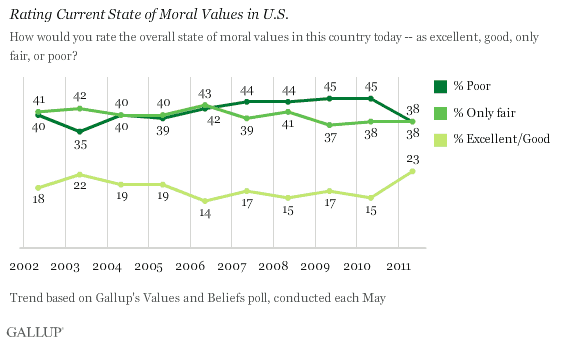
The seven-point decline in negative reviews of U.S. morals over the past year is roughly matched by an eight-point increase, from 15% to 23%, in those describing morals as "excellent" or "good." The percentage calling them "only fair" is unchanged at 38%.
Americans are also slightly more optimistic than they were a year ago about the direction in which the nation's morals are headed, according to this year's Gallup Values and Beliefs survey, conducted May 5-8. About 7 in 10 Americans (69%) now say moral values in the country as a whole are getting worse, down from 76% last year.
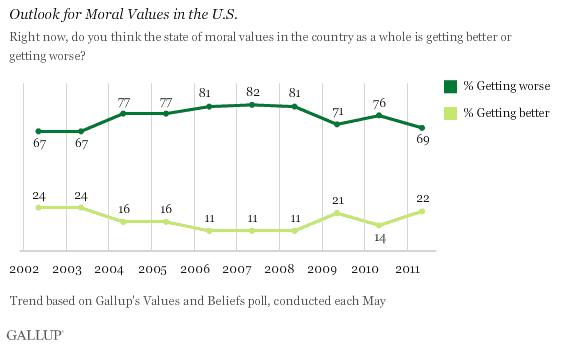
The net result of these two trends is a slight improvement in Americans' overall assessment of moral values. Roughly two-thirds -- 65% -- now have a negative view of moral values. This represents the percentage of Americans who think moral values are only fair or poor and either worsening or staying the same. Just 14% have a positive view of morals, saying they are excellent or good and either improving or staying the same. Another 18% fall somewhere in between in their views.
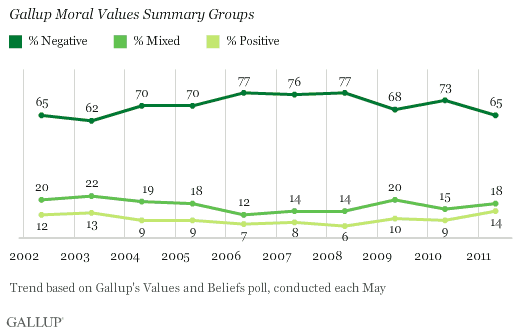
Democrats' Negativity Toward Moral Values Has Declined the Most
The change in public perceptions about the nation's morals has come mostly from Democrats. Fifty-two percent of Democrats have a negative view of moral values, down from 65% in 2010. Democrats' views of morality in the United States have changed direction several times in the past four years -- their negativity rose to 77% in 2008, and then turned sharply less negative in 2009, coincident with Democrat Barack Obama's taking office as president, but increased again in 2010.
Independents also became less negative about morals this year, while Republicans' views did not change and, as such, remain mostly negative.
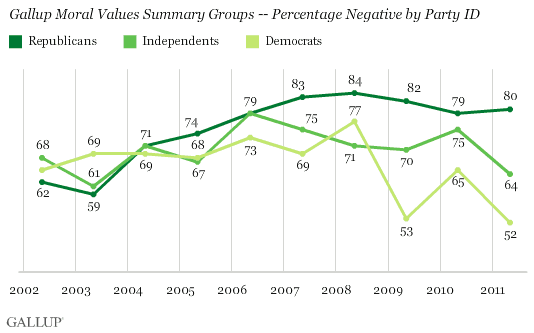
More generally, Republicans have grown significantly more negative about the state of moral values since 2003, while independents' views also grew more negative before improving this year. From 2002 through 2007, Democrats' views held at a moderately negative level, ranging from 65% through 73%, but have been more volatile since then.
The fairly sizable distinctions in how the party groups currently evaluate moral values in the country are similar to differences seen by political ideology. There are also significant differences by age, with negative views moving progressively higher from the younger to the older age groups. Men and women, however, hold similar views.
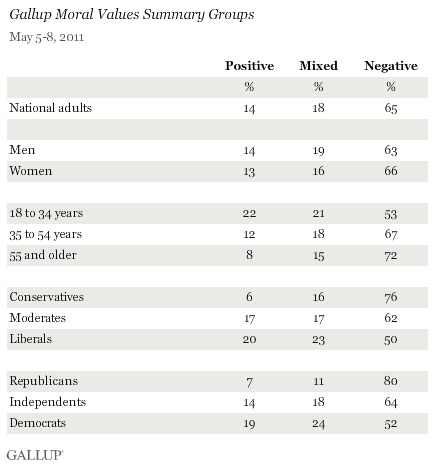
Bottom Line
Americans today are more positive in their overall perceptions of the state of moral values in the country than they were in May 2010. No more than one in four are willing to describe the country's morals in highly positive terms; however, the percentage calling them "poor" declined, and a diminished majority now believes morals are getting worse. These ratings were taken prior to the revelation of a major sexual scandal involving former California Gov. Arnold Schwarzenegger, and news that former U.S. Sen. John Edwards may soon face criminal charges over an alleged cover-up of his own sex scandal. However, given the trends by party ID in Americans' ratings of moral values, it appears that Americans' reactions to the moral leadership of the president, or perhaps to the moral implications of government policies, may play a bigger role in the formation of these views than news about the behavior of specific individuals.
Survey Methods
Results for this Gallup poll are based on telephone interviews conducted May 5-8, 2011, with a random sample of 1,018 adults, aged 18 and older, living in all 50 U.S. states and the District of Columbia.
For results based on the total sample of national adults, one can say with 95% confidence that the maximum margin of sampling error is ±4 percentage points.
Interviews are conducted with respondents on landline telephones and cellular phones, with interviews conducted in Spanish for respondents who are primarily Spanish-speaking. Each sample includes a minimum quota of 400 cell phone respondents and 600 landline respondents per 1,000 national adults, with additional minimum quotas among landline respondents for gender within region. Landline telephone numbers are chosen at random among listed telephone numbers. Cell phones numbers are selected using random digit dial methods. Landline respondents are chosen at random within each household on the basis of which member had the most recent birthday.
Samples are weighted by gender, age, race, Hispanic ethnicity, education, region, adults in the household, and phone status (cell phone-only/landline only/both, cell phone mostly, and having an unlisted landline number). Demographic weighting targets are based on the March 2010 Current Population Survey figures for the aged 18 and older non-institutionalized population living in U.S. telephone households. All reported margins of sampling error include the computed design effects for weighting and sample design.
In addition to sampling error, question wording and practical difficulties in conducting surveys can introduce error or bias into the findings of public opinion polls.
View methodology, full question results, and trend data.
For more details on Gallup's polling methodology, visit www.gallup.com.
